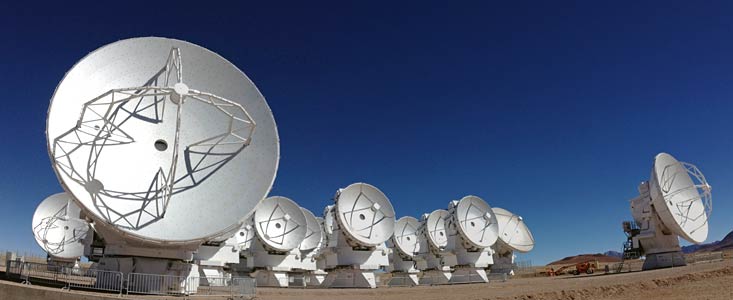Announcement
Powerful New Hardware Approved for ALMA
19 January 2018
The development of a new spectrometer for the Morita Array, which forms part of the Atacama Large Millimeter/submillimeter Array (ALMA), has been approved by the ALMA Board. Developed by Japan, the Morita Array is composed of twelve 7-metre antennas and four 12-metre antennas. The new spectrometer will be dedicated to the four 12-metre antennas under the ALMA Future Development Program, which aims to maintain ALMA’s capacity to produce remarkable scientific results.
ALMA creates very sharp images by linking multiple antennas together to form a giant virtual telescope that can be up to 16 kilometres in diameter. The Morita Array forms one part of ALMA, and comprises antennas with small separations [1]. Radio waves collected by the ACA antennas are processed by the ACA Correlator, which combines the data from all of the antennas [2].
At present the ACA Correlator is optimised to process signals from the twelve 7-metre antennas, the system is not optimised for the four 12-metre antennas working as a single-dish telescope. With this development, signals from the 7-metre antennas will continue to be processed by the ACA Correlator, while signals from the 12-metre antennas will be separately processed by the new spectrometer, maximising the capability of the Morita Array [3].
The new GPU-based spectrometer [4] is being developed by the Korea Astronomy and Space Science Institute (KASI) and the National Astronomical Observatory of Japan (NAOJ). KASI is responsible for the design, development, verification and shipping, while NAOJ assumes the development and system design of software and hardware, and the integration of the spectrometer into the rest of the ALMA system. It is planned to deliver the new spectrometer to ALMA in 2020 [5].
Notes
[1] Also known as the Atacama Compact Array, the compact nature of the Morita Array allows ALMA to study celestial objects with a large angular size, such as molecular clouds and nearby galaxies.
[2] The ACA Correlator is a huge data processing system consisting of 52 modules connected to each other via optical fibres. It correlates data from the antennas and transfers it to ACA data processing computers, transforming photons into photos.
[3] The new system will be a “spectrometer” rather than a “correlator” because spectroscopy is required when processing data from the 12-metre antennas, but correlation is not necessary. In the case of the Morita Array, spectroscopy involves dividing radio waves into different frequency ranges.
[4] A GPU, or graphics processing unit, is an electronic circuit designed to accelerate the creation of images intended for output to a display device. GPUs are used in embedded systems, mobile phones, personal computers, workstations, and games consoles.
[5] Test observations with the spectrometer integrated into ALMA will commence in 2020.
More Information
The Atacama Large Millimeter/submillimeter Array (ALMA), an international astronomy facility, is a partnership of ESO, the U.S. National Science Foundation (NSF) and the National Institutes of Natural Sciences (NINS) of Japan in cooperation with the Republic of Chile. ALMA is funded by ESO on behalf of its Member States, by NSF in cooperation with the National Research Council of Canada (NRC) and the National Science Council of Taiwan (NSC) and by NINS in cooperation with the Academia Sinica (AS) in Taiwan and the Korea Astronomy and Space Science Institute (KASI).
ALMA construction and operations are led by ESO on behalf of its Member States; by the National Radio Astronomy Observatory (NRAO), managed by Associated Universities, Inc. (AUI), on behalf of North America; and by the National Astronomical Observatory of Japan (NAOJ) on behalf of East Asia. The Joint ALMA Observatory (JAO) provides the unified leadership and management of the construction, commissioning and operation of ALMA.
Links
Contacts
Masaaki Hiramatsu
NAOJ Chile Observatory EPO officer
Mintaka, Tokyo, Japan
Tel: +81 422 34 3630
Email: hiramatsu.masaaki@nao.ac.jp
Richard Hook
ESO Public Information Officer
Garching bei München, Germany
Tel: +49 89 3200 6655
Cell: +49 151 1537 3591
Email: rhook@eso.org
About the Announcement
| Id: | ann18003 |

